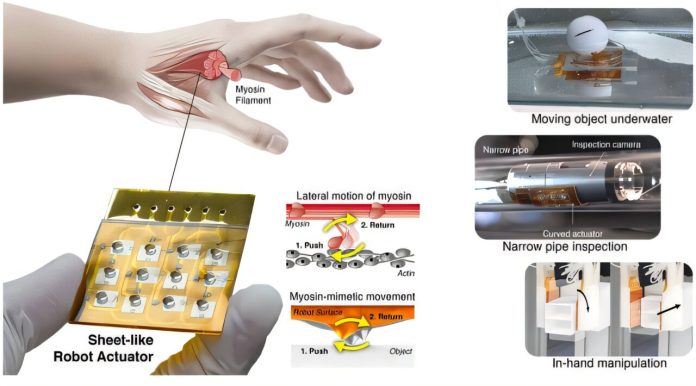
Scientists in South Korea have created a super thin and flexible robot that moves like a muscle, opening the door to future robots that can navigate tight spaces, perform delicate tasks, and even assist in surgeries.
Developed by a research team at POSTECH (Pohang University of Science and Technology), this new type of robotic actuator is as thin as a sheet of paper but surprisingly strong and adaptable.
The results were recently published in Nature Communications.
Most robots today are made from hard metal parts, which makes them strong but limits their movement—especially in narrow or delicate spaces.
This new robot, however, is soft, flexible, and inspired by how human muscles work.
In our bodies, muscle proteins like myosin create large movements by repeating tiny, precise contractions.
The research team used this idea to design a soft, sheet-like robot that mimics these natural movements.
At first glance, the robot may look like a simple flexible sheet. But hidden inside are dozens of tiny air chambers and a network of thin air tubes.
When air is pumped through these channels in a specific sequence, the surface of the robot forms small bumps that move in different directions. These tiny motions add up, creating enough force for the robot to crawl, twist, bend, and move with precision—even through tight or curved spaces.
In experiments, the robot could manipulate small objects with gentle, finger-like control and even move underwater. It successfully completed tasks like handling delicate items and navigating through narrow pipes—jobs that are often impossible for traditional rigid robots.
One of the most exciting applications is in medicine. The robot could one day assist with minimally invasive surgeries, moving through small openings inside the body to perform precise procedures.
In industry, it could help inspect and clean machinery in tight areas. The team also sees potential for home robots that interact more gently and safely with people, such as in caregiving or cleaning roles.
The research was led by Dr. Hyung Gon Shin, a former Ph.D. student at POSTECH now working at Samsung Electronics’ Future Robotics Division, along with Professors Keehoon Kim and Wan Kyun Chung.
Professor Kim said, “We were able to combine a complicated 3D air control system into a thin and flexible sheet, and make it move in many directions using ideas from biology.
This could lead to a new generation of soft, adaptable robots for many different jobs—from hospitals to homes to deep exploration.”



